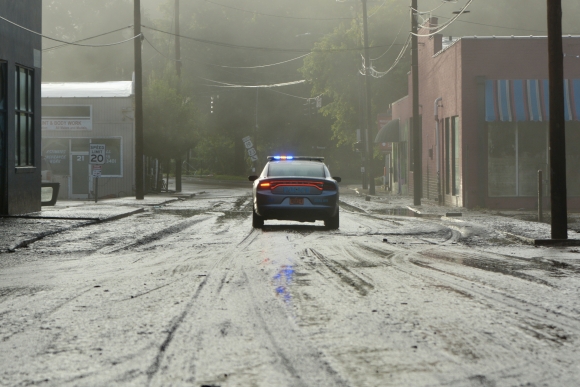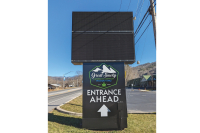The Pigeon River Flood of 2021
 A police car blocks a mud-slicked road in Downtown Canton around 7 a.m. on the morning of Aug. 18.
Cory Vaillancourt photo
A police car blocks a mud-slicked road in Downtown Canton around 7 a.m. on the morning of Aug. 18.
Cory Vaillancourt photo
Editor's note: As the sun rose above Haywood County on the morning of Aug. 18, residents and first responders were hard at work surveying flood damage from the remnants of Tropical Storm Fred. Smoky Mountain News staff were there too, gathering photos and firsthand reports. This page will be updated throughout the coming days as photos and stories continue to arrive from across the county.
9:08 a.m., Wednesday Aug. 18, 2021 - Holly Kays
Heavy rain caused river surges and floods across the region yesterday, with some areas seeing more than a foot of rain in less than three days.
Between midnight Sunday, Aug. 15, and 5 p.m. Tuesday, Aug. 17, a weather station at the Cruso Fire Department in Haywood County picked up 14.17 inches of rain, according to Local Yokel Weather. Between midnight Sunday and 4 p.m. Aug. 17, Rock Bridge adjacent to Panthertown Valley in Jackson County reported 12.4 inches, the Balsam Grove Fire Department in Transylvania County reported 12.28 inches and Wolf Creek Lake in Jackson County saw 11.38 inches, Local Yokel reported.
Weather stations across the region were reporting upwards of 3 and 4 inches of rain between Tuesday and Wednesday morning, but the Cruso Fire Department saw a whopping 8.92 inches in that 24-hour period, according to U.S. Weather Service data.
Peak river flows in the area were extremely high, with a U.S. Geological Survey gauge in the West Fork Pigeon River above Lake Logan reporting a peak depth of nearly 10 feet on Aug. 17 compared to a sustained depth of less than 2 feet in the previous days. The Pigeon River near Canton nearly reached 20 feet in depth, compared to about 2 feet in days leading up to the rainstorm.
Related Items
Other areas also saw significant increases in river depth, with the Oconaluftee River at Birdtown in Cherokee reaching a peak just under 7 feet Aug. 17 compared to about 1.5 feet in previous days while the Little Tennessee River at Iotla topped 8 feet, compared to about 2 feet previously. The Tuckasegee River at Barkers Creek hit 10.5 feet Aug. 17 after hanging around 4 feet in depth prior to the storm.
10:34 a.m., Wednesday Aug. 18, 2021 - Cory Vaillancourt
Haywood County EMS will hold a media briefing today at noon to provide an update on the situation in the aftermath of Tropical Storm Fred. The briefing will be held in the parking lot of the Ingles grocery story located at 1670 Brown Avenue, in the Hazelwood section of Waynesville. Check back for updates.
10:54 a.m., Wednesday Aug. 18, 2021 - Cory Vaillancourt
Canton Alderwoman Kristina Smith reports that the towns of Canton and Clyde are under a boil advisory. Smith also says that the best way to help first responders assess and respond to damage is to stay off the roads if possible.
12:35 p.m., Wednesday, Aug. 18, 2021 - Cory Vaillancourt
More than 30 people remain unaccounted for and search and rescue operations continue at this hour after heavy rainfall from Tropical Storm Fred slammed southeastern Haywood County last night, pushing the East Fork of the Pigeon River out of its banks.
Subsequent flooding throughout Crusoe, Lake Logan, Clyde and Canton swept homes from foundations, clogged bridges with debris and closed silt-slicked roads across the area.
“Yesterday afternoon we started getting reports about high water and at approximately 3 p.m. Haywood County Sheriff’s Office deputies began to assist families in evacuating areas that were at risk of flooding,” said Sheriff Greg Christopher at a noon press conference.
Evacuation quickly turned to rescue, with the help of specially trained water rescue units from across the state, according to Christopher.
“We have been searching abandoned vehicles, homes and buildings for survivors and will continue to search until every community member is located or at least accounted for,” Christopher said, imploring residents not to drive through standing water, and to remain at home off the roads if at all possible.
Although significant damage was reported in downtown Clyde and Canton, Lake Logan and especially Cruso seem to have borne the brunt of the damage. Sheriff Christopher couldn’t yet confirm any deaths, but said detectives were investigating widespread reports.
Todd Ford, whose home is between the East and West Forks of the Pigeon River in Bethel, said the water came so fast it was scary. He said the two rivers came together just in front of his home, which is perched on higher ground.
“Sometime between 5 and 6 p.m., the rivers just started coming together. I could see water on one side, and then the two just joined together so fast I couldn’t do much,” said Ford. “Thankfully my family was already evacuated.”
Another couple who did not want to give their names but live in a campground near the Cruso Community Center told a reporter for The Smoky Mountain News that they feared that many residents of Laurel Creek Campground may have lost their lives. They said they’d been told that residents huddling in a pavilion in the campground had been swept away by the raging waters during the storm.
Dozens of bridges and roads in the area are damaged, including several sections of U.S. 276. A mobile home was left resting on U.S. 276, and it had pushed a utility building and a car into a tree.
Both cell phone and landline telephone service to Cruso are currently down, and boil orders have been issued in Canton and Clyde.
“We need people to stay away so the rescuers and searchers, our Department of Transportation, law enforcement, fire departments, will be able to continue to move about in the communities as they need to in order to help these people who need us so desperately,” he said.
Haywood EMS Director Travis Donaldson, speaking just before Christopher, said that the Pigeon River peaked at 19.6 feet, and that Cruso remains closed to traffic at Jukebox Junction. A temporary shelter at Tuscola High School reported 54 people had taken refuge there.
Western North Carolina’s Sen. Kevin Corbin, R-Franklin, said last night in a Facebook post that he and Rep. Mark Pless, R-Haywood, were working within state government to mobilize assistance to the area.
Congressman Madison Cawthorn, who appeared at the press conference, said that he and his team had been on the ground surveying damage, and that he’d sent a letter to President Joe Biden asking for an emergency declaration. Cawthorn also said he’d spoken with North Carolina Gov. Roy Cooper earlier.
“The people of Haywood County are known for their rugged individualism. They’re known for their strength and I’m asking them to call on that now, to heed the guidance of local officials,” Cawthorn said. “What the sheriff has done here, the local EMS, the rescue squads, water evacuation squads and local fire chiefs have done, is to be commended. We have an incredible group of first responders here. I believe the federal government will be doing all it can, especially on my behalf, from my office, to assist the people who’ve been affected the most.”
Christopher said he hadn’t received any reports of injury or deaths among law enforcement, first responders or rescue personnel.
SMN Editor Scott McLeod contributed to this report.
3:09 p.m., Wednesday, Aug. 18, 2021 - Garret K. Woodward
It’s about a mile past Jukebox Junction, down along U.S. 276 heading towards the small mountain community of Cruso, when the strong, pungent smell of mud wafts into the open truck windows and up through your nostrils.
Another mile or so past that, you start to catch wind of the odor of gasoline and propane. Gasoline from vehicles flipped upside down in driveways. Propane from large tanks tossed onto the shoulder of the debris-covered road from houses hundreds of yards away.
Flowing alongside U.S. 276 at a frantic pace, the riverbanks of the East Fork of the Pigeon are littered with furniture, car parts, vinyl siding from homes, windowpanes, tractor tires, buckets, children’s toys, and seemingly everything else one could imagine.
The adage “everything but the kitchen sink” doesn’t adequately describe just how much debris is scattered along this low valley shadowed by steep, high peaks. You also can’t imagine how high, fast and unmerciful the river actually was Tuesday night, at least until you see thick mud and heavy rocks atop bridges some 15-feet above the waterline at mid-day Wednesday.
Farmland now covered in mud. With harvest season right around the corner, the once-ripe crops are ripped from the earth and carelessly dropped wherever the rushing water started to recede this morning.
Turning onto Burnette Cove Road, members of the Town of Cary Water Rescue Unit, fresh from a long drive to lend a hand, are standing in a semi-circle, discussing the strategy in checking submerged buildings and automobiles, more so in search of the numerous names that are still missing — precious minutes and hours ticking away under a hot late summer sun.
Heading up Burnette, sheds and small structures are demolished into kindling. A Chevy Suburban is crunched against a large tree, one of the few trees near the river that wasn’t snapped like a toothpick and shot downstream like a cannonball.
Further up the dead-end road, there are neighbors crossing the street to check on loved ones. Others sit on their porch and simply wait, for there’s not much else to do at this juncture of destruction and confusion.
Conversation hovers around a family a few houses down who was found clinging to a tree to escape the rising waters in the middle of the night, only to be safely rescued by neighbors who kids grew up with their kids, who trucks they would pass and wave to in solidarity on any other quiet, unassuming Wednesday.
Some talk of previous floods, where the infamous 2004 saga seems to pale in comparison to Aug. 17, 2021. There’s also mention of the one in the 1970s, an endless string of memories flooding the minds of those who never forgot the last time their community washed away into the unknowns of tomorrow.
One neighbor cranks up the lawn-mover and starts taming the tall grass in his front yard. Maybe he’s sticking to his intended chores for the day. Or maybe he’s just in need of a distraction from what’s just over his shoulder and down the hill. The latter seems to be the call of the day for the solemn figures standing around, questioning once again: Why do bad things happen to good people? Where to go from here? And what now?
Many can’t fathom the idea of pulling up stakes and heading for somewhere, anywhere else. This is home. And for most, it’s a valley they’ve proudly called home for generations that stretch back centuries.
The house is gone. The car is totaled. But, at least for now, “we are safe and accounted for.” Hug each other tight. Wipe the mud off your boots. Find a bottle of water or can of beer from the fridge, the last appliance standing in countless homes. Sip the beverages and sigh — in relief, and in sorrow.
Meandering by the Springdale Country Club, there’s a boulder the size of a king-cab truck blocking the oncoming lane. The recently renovated golf course is a mud pit. The front-nine is ripped up. More furniture and debris strewn about the tee boxes and fairways that were pristine at this time yesterday.
Across the road, a Ford Crown Victoria is high up in a tree, the nose of the vehicle pointed downward towards the river. One can only imagine the force and magnitude of the wall of water it must’ve taken to launch the 4,100-pound vehicle several feet into the air, let alone where the Vic even originated from.
And yet, even amid the absolute destruction of this tightly-knit, iron-willed community, many count their blessings. “It could have been worse, much worse for us. I can’t even imagine how bad it was down the river,” one survivor mumbled in a humble tone of compassion and grief.
By the time the Cruso Fire & Rescue Station comes into view, you also bear witness to a mobile home slammed into a tree, mere feet from the station. Somehow, sandwiched within the mobile home and the tree, there’s a shed and a sedan smashed between the structure and the large plant, resembling some accordion that was stepped on and discarded.
Surrounding the station, there are dozens of rescuers and law enforcement officials from near and far, innumerable linemen and highway personnel — all running around in an effort to clear the roads, check the homes, and contain the tragic scene unfolding before their eyes.
Many of these rescuers are heading across a shattered bridge and into the ill-fated Laurel Bank Campground, quite possibly ground zero for the hardest-hit spot of the flood impact zone. A somber, dreadful feeling washes over the faces of those having to go over the bridge.
Turning back towards Jukebox Junction, the Cruso Fire & Rescue Station is now in the rearview mirror. So are all the rescuers and officials. What are they currently thinking or feeling? What else will they, sadly, uncover? Yet again, that unanswerable, ancient question bubbles up within, “Why do bad things happen to good people?”
Passing back by the once-sturdy homes, broken windows and cracked doorframes are seen, the front door probably now on a riverbank somewhere. Slowly snake up U.S. 276. Familiar faces in front yards, heads hanging low with both hands in the pockets of dirty jeans. The sound of the mighty Pigeon River across the way — once a portal for peace and serenity, now a constant reminder of a night when the rain just wouldn't stop.
And even though you cross back through Jukebox Junction, you still can’t get the smell of mud, gas and propane out of your nose, more so your memory from this day forward.
12:45 p.m. Thursday, Aug. 19, 2021 - Cory Vaillancourt
As Haywood County continues to assess damage from the Pigeon River flooding associated with excess rainfall from Tropical Storm Fred on Aug. 18, local officials are asking for help in a number of ways while noting a pair of grim milestones associated with the destruction.
“Our residents are strong. Haywood County is resilient, and we're all North Carolinians. We're standing strong, but we're needing support,” said Haywood EMS Director Travis Donaldson. “We need your prayers and your thoughts.
Donaldson led off a press conference earlier today on the grounds of Canton’s flooded-out W.G. Stamey Municipal building, but Canton Mayor Zeb Smathers was asking for more than just thoughts and prayers.
“As you can see, our town hall, our basic structures, our houses, our police department, our fire department, our emergency response - it is completely offline,” Smathers said, before leading U.S. Sen. Thom Tillis on a walk through Canton’s mucky downtown, where several feet of water stood just 36 hours ago. “What you will see on this tour, you will go through our river businesses and homes that have been affected. This storm was so intense that one of our alderman, Dr. Ralph Hamlet, has lost his home. The intensity of the storm literally pushed it off the foundation."
Smathers said he thought this most recent flood was worse than the historic 2004 floods that slammed Canton back when his father Pat was mayor. Smathers went on to plead for a federal emergency declaration that would free up aid, especially housing resources.
In the immediate wake of the storm, more than 30 people were unaccounted for, but that number’s since dwindled to around 20 as search and rescue operations continue. Sadly, two deaths have now been confirmed, with further details forthcoming.
Kevin Ensley, chairman of the Haywood County Board of Commissioners, said that more than 500 people had been displaced, and the area around Bethel, Cruso and Lake Logan remains isolated and devastated.
“We have probably 10 to 30 bridges out from the public safety standpoint, and education and quality of life,” Ensley said. “Folks are cut off for an extended period of time, so we're looking to the state and the federal government to help those folks with bridge repair and with their homes.”
Sheriff Greg Christopher repeated calls for people to stay out of the Cruso area as contractors and rescue teams move in and out.
County officials had no answer as to when phone and electric service could be restored for those currently experiencing outages.
Resources are available for those residents on the perimeter of the area, and a makeshift shelter at Tuscola High School is still in use as well, although few people remain there.
People who are not in life-threatening situations but still need help are encouraged not to call 911, but to call a special help line established for this purpose: 828.356.2022.
Smathers will host N.C. Gov. Roy Cooper around 2:30 p.m. today for a tour of Cruso.
3:15 p.m., Friday, Aug. 20, 2021 - Garret K. Woodward
It’s late Friday morning. With cloudy skies above and a cool breeze swirling around her, Aubrey Ford gazes out onto what’s left of her front yard and the multiple homes on her family’s property following the raging floodwaters Tuesday night. She lights a cigarette and exhales with a sigh.
“The yard was ankle-deep in water, next thing I know it’s waist-deep with how fast the river was rising — everything just happened so fast,” the Bethel resident said.
The part of the small Haywood County farming community of Bethel where Ford lives is situated at the intersection of U.S. 276 and N.C. 110. — right at the confluence of the mighty Pigeon River and Bird Creek. Located along Max Thompson Road, just north of the intersection, Ford’s house is perched a hundred yards or so from the East Fork of the Pigeon River, the homes of her parents and grandparents within earshot.
“My house looked like a boat house there was so much water,” Ford marveled. “The water level was right up to the porch. All of us got trapped and headed for higher ground until the river either went down or we got rescued.”
At about 5 p.m. Tuesday, the Pigeon River started to overtake the banks and flood the front yard. Ford ran to her home and grabbed anything she might need to take care of her 9-month old baby (safely placed in her parents’ farmhouse up the hill behind her home).
“It was the wildest thing — the river rose and the sun was shining,” Ford said.
The water was only a few inches deep in the yard at that point. But, by the time Ford emerged from her home with the baby supplies and headed to the farmhouse, she found herself wading through the muddy water, which was quickly picking up speed.
“We all ran to the farmhouse. But, my brother and his 12-year-old son tried to get back to his truck on the road and head for their house,” Ford said. “They made it about halfway across the yard when my nephew got swept away in the current.”
The 12-year-old was flung down Max Thompson Road (now a raging river), past the freshly demolished Accurate Auto Repair, only to swim to higher ground and get rescued by his father. The duo trudged through the mud and debris to their Chevy Trailblazer and tried to start the engine.
But, by this time, the water had reached the windows, with the SUV now stuck in the middle of N.C. 110. Unable to open their doors because of the force of the water, father and son rolled the windows down, climbed out of the vehicle and waded to safety, eventually making it back to their house uphill on nearby Sonoma Road.
“All you could hear was debris and rocks hitting the houses below, smashing through the auto repair shop,” Ford recalled. “The worst was hearing all the debris slam into the bridge. There was this big storage shed that just crumbled into the bridge. All kinds of debris and trees hitting it — it felt like it would never stop.”
Sitting right next to the old farmhouse, the bridge is currently a disaster area. Huge chunks of asphalt and concrete that once stabilized the structure now lay in nearby cornfields. The amount of force needed to move these thousand-pound objects is unfathomable.
All around the bridge and front yard are pieces of furniture, refrigerators, mattresses, bags of ramen noodles, shoes, children’s toys, etc. — each item from someone else’s home further upstream. And scattered in seemingly every direction are hundreds, perhaps thousands, of green peppers from decimated farmland on the other side of the community.
At one point, a baby cow floated down the river and got trapped in the debris on the bridge. Neighbors ran outside amid the ravaging flood and were able to save the frightened animal.
“We called 911 and they told us to keep finding higher ground until they could get help out there,” Ford said. “So, we huddled together in the farmhouse and waited it out through the night, not knowing what would happen next or if the water would stop rising.”
By midnight, the water was still extremely high and dangerous, with the level of the river now overtaking the bridge and climbing the hill, ultimately flooding the basement of the farmhouse.
“We were worried when we started to smell gasoline, because the gas tanks we had in the basement had tipped over and spilled out when the water rushed in,” Ford said.
Now several hours into the fiasco, help did arrive. But, it wasn’t local officials.
“It was the Wilmington Search and Rescue team,” Ford shook her head in amazement. “They evacuated us and we were able to go to my uncle’s house in Canton.”
Returning to their home Wednesday morning, Ford and her family were now able to see the size and scope of the wrath wrought upon them and the rest of the Bethel community and upriver in Cruso. Destroyed vehicles. Piles of debris from god knows where. The porch ripped off her grandparents' home and strewn across the yard. A sea of brown mud and water covering the once green and lush lawn.
Ford said that this flood was way worse than the catastrophic 2004 incident, which she remembers vividly, the river spilling into the same front yard those many years ago. This isn’t Ford’s first flood, and it most likely won’t be her last. She remains, as does her family. This is their home, and always will be — come hell or high water.
“Everything here is materialistic stuff. It can all be replaced. We can start over, start fresh and rebuild, and we will,” Ford said. “But, you can’t replace people, you can’t replace the ones you love. We’re just lucky to be alive and that everyone in our family is OK. But, this isn’t necessarily the case for other families along this river.”
5 p.m., Friday, Aug. 20, 2021 - Holly Kays
The U.S. Forest Service is discouraging visitors from recreating in the Pisgah Ranger District this weekend as staff work to assess and correct the safety situation.
“At this time we ask everyone to stay patient and be cautious if and when choosing to enter the Forest,” said District Ranger Dave Casey.
Staff have found bridges out, trails eroded and trees down in their assessments thus far. Staying out of the forest for the time being will help ensure the safety of staff and visitors alike as staff work to clear areas.
Meanwhile, the Blue Ridge Parkway remains closed from U.S. 276 to N.C. 215, mileposts 411.9 to 423.2, and the closure applies to all users, not just motorists. The closure is due to multiple small landslides, and the area will open after engineers complete inspections to ensure the road is not compromised or damaged. Hazardous trees, downed trees and heavy equipment in these areas make it unsafe for cyclists or hikers to recreate behind the gates.
“Park staff have worked over the past few days to restore access in as many areas as possible.” said Blue Ridge Parkway Superintendent Tracy Swartout. “The remaining closures in place require additional time to address, and we appreciate the public’s cooperation by avoiding these areas.”
In addition, many roads key to accessing popular recreation areas are closed in order to allow first responders and residents to effectively conduct recovery efforts. This includes U.S. 276 from Jukebox Junction to the Blue Ridge Parkway and N.C. 215 from Lake Logan until just shy of the Parkway.
For updated traffic information, visit www.drivenc.gov.
5:30 p.m., Friday, Aug. 20, 2021 - Holly Kays
While the Cruso area undisputedly received the worst of the flooding in Western North Carolina, it did not receive the worst of the rainfall.
Over the 72-hour period from 8 a.m. Sunday, Aug. 15, to 8 a.m. Wednesday, Aug. 18, Cruso received about 14 inches of rain. But multiple gauges on the Transylvania/Jackson County line recorded more than 20 inches in that same time period, said National Weather Service Meteorologist Trisha Palmer.
However, those areas didn’t see major flood damage, because the heavy rainfall was concentrated right along the Eastern Continental Divide. Instead of all flowing into a single watershed, some of it flowed into the Upper French Broad watershed headed toward Brevard while some flowed south toward Lake Toxaway and South Carolina.
“If it had fallen just a little bit further north or a little bit further south, it would have all fallen into one basin and been funneled down in one direction,” said Palmer. “It would have been an incredible flood wave. It was already incredible, but it would have been even more incredible.”
As it is, Jackson County saw only minor flood damage, said Emergency Management Director Todd Dillard.
“We did have one home damaged up in the Canada community, and that residence has considerable damage to it, but she has family where she’s being taken care of,” Dillard said. “We had a few minor landslides. We had our normal flooding where we usually do out on Ashe Settlement Road (in Webster).”
Jackson County, especially in the northern end, has the additional buffer of the Duke Energy reservoir at Lake Glenville. The lake provides enough buffer so that, if rainfall is significant enough that the company must spill water from the dam, emergency services can be warned beforehand.
“We really fared very well compared to Haywood County,” said Dillard.
He spoke by phone from the flooded area in Haywood, where he and two of his employees were assisting in the recovery effort. More than 200 people representing emergency services agencies from all over the state and beyond are currently on site.
5:35 p.m., Friday, Aug. 20, 2021 - Holly Kays
Two additional fatalities of the flooding from Tropical Storm Fred have been confirmed, and their bodies have been located and recovered.
“We would like to extend our sympathies to all the families who have been affected by this tragedy and most especially to those who have lost loved ones,” said Sheriff Greg Christopher.
Identification and family notification are underway, and more information about the individuals will be released after that process is completed. This brings the number of confirmed dead to four.
10 a.m., Saturday, Aug. 21, 2021 - Holly Kays
The N.C. Department of Agriculture and Consumer Services will activate its hotline beginning Saturday, Aug. 21, to connect farmers with resources that can assist with damage and other agricultural emergencies related to the storm. The toll-free number is 1-866-645-9403. A live operator will be available on the hotline between 8 a.m. and 5 p.m. daily.
“The crop, nursery and infrastructure damage in Western N.C. is devasting,” said Agriculture Commissioner Steve Troxler. “It will take some time to fully assess agricultural damages and I encourage farmers with damage to call us with any assistance they may need.”
Farmers can also find recovery resources on the department’s disaster Web pages, www.ncagr.gov/disaster.
5 p.m., Sunday, Aug. 22, 2021 - Holly Kays
The fifth victim, Frank Lauer, Sr., 74, of Cruso was located today, and his family has been notified.
“I extend my deepest condolences to Mrs. Lauer and her family. We are holding the Lauer family close in our hearts, and are praying for them now in the time of their loss,” said Sheriff Greg Christopher.
The other people confirmed dead as a result of the storm are Frank Mungo, 86, Franklin McKenzie, 68, Judy Mason, 73, Charlene Mungo, 83, all of Cruso.
Verizon and AT&T Cellular services in the affected areas have now been restored, and power has been restored to 95% of the Cruso community. Chinquapin Road Bridge has been repaired and is open to traffic as of 9 p.m. last night. Heavy equipment teams are moving into the area and beginning the process of clearing the largest debris piles.
Residents removing debris should refrain from piling it on state roads, as this may block access for rescue vehicles and other essential traffic. Residents should document debris as much as possible with photographs before they move it so that complete damage assessments can be made.
The Western North Carolina Flooding Home Cleanup Hotline number is 828.222.3975.
11 a.m. Wednesday, Aug. 25 — Holly Kays
Until further notice, the speed limit on U.S. 276 / Cruso Road in Haywood County between the Blue Ridge Parkway and N.C. 110 is set at 35 miles per hour in order to increase safety and to protect the integrity of the road during Tropical Storm Fred recovery. Drivers should also expect that the Chinquapin Road bridge in Cruso will be closed intermittently to facilitate ongoing repairs.
11:30 a.m. Wednesday, Aug. 25 — Holly Kays
The Sliding Rock Recreation Area in the Pisgah National Forest is closed, and law enforcement personnel are present to prevent entry to the popular site. Facility infrastructure is damaged, and the pool contains large amounts of debris. Visitors should stay out of the area for their own safety and that of first responders.
Additionally, Skinny Dip Falls, accessed from mile 417 of the Blue Ridge Parkway, is unsafe to visit. The bridge has been swept away and the path of the water has completely changed.
National forest visitors should not hike to known landslides or mudslides, as they are dangerous and unstable for all forms of traffic, including vehicle, foot, horse and bicycle. The Appalachian Ranger District is currently discouraging use of any Forest Service roads, trails and dispersed camping sites around Burnsville, Hot Springs and Barnardsville in order to allow ongoing safety and damage assessments to be completed.
All storm-related closures on the Blue Ridge Parkway have been lifted, but visitors should drive carefully and avoid areas impacted by last week's rains.
Many parts of Panthertown Valley in the Nantahala National Forest were impacted by the storm, and a full trail assessment is in the works. In order to help protect the resource, visitors should use caution on the trails. Water levels are higher than usual, and creek crossings may be impassable. Soil conditions are soggy and may be unstable — mud on boots is a guarantee.
Newfound Gap in the Great Smoky Mountains National Park is currently closed due to a rockslide that occurred near mile marker 13 around 9 p.m. Tuesday, Aug. 24. The road is closed from the intersection with Little River Road, near Sugarlands Visitor Center, to Smokemont Campground Road. Access to Smokemont Campground remains open from the North Carolina side.
11:35 a.m. Wednesday, Aug. 25 — Holly Kays
As floodwaters recede and cleanup continues, the N.C. Department of Agriculture and Consumer Services urges farmers and homeowners to evaluate pesticides and other chemical storage areas. Disposal assistance is available.
“If your pesticide or fertilizer storage area was underwater because of flooding, materials could be damaged, leaked or spilled,” said Agriculture Commissioner Steve Troxler. “There are ways to safely handle and remove these chemicals. Do not mix chemicals when cleaning up due to potential reactions. A good rule of thumb is to keep solids separate from liquids and keep unlike chemicals separate.”
The Pesticide Disposal Assistance Program is revising its collections schedule based on assistance needs after Tropical Storm Fred. Dates will likely be added for the western part of the state and posted at www.ncagr.gov/PDAP.
When cleaning up chemicals in flooded areas, keep the following in mind:
-
Safety. If you suspect your pesticide storage area has flooded, use caution in investigating the area. Wear personal protective equipment such as chemical-resistant gloves, rubber boots, protective clothing and eyewear.
-
Assess the area and contain the spread. Evaluate and identify the problem areas and use absorbent materials to contain the spread of the spill.
-
Cleanup. After stabilizing the area, begin cleaning it up. It is important that cleanup be prompt, but also safe. Things to consider include identifying a place to temporarily store the flooded material before ultimate disposal and plans for how to dispose of the pesticides. Make sure this temporary site meets proper pesticide storage regulations and keeps products out of the weather. Do not load all chemicals into one bin or container. This could not only create safety concerns and adverse chemical reactions, but it could create response delays and increase disposal cost.
The Pesticide Disposal Assistance Program of NCDA&CS will provide information and assistance with material disposal. Information on PDAP is online at www.ncagr.gov/PDAP, or email questions to This email address is being protected from spambots. You need JavaScript enabled to view it. or call 919.280.1061. When contacting by email or phone, include contact name, county where the material is located, best contact phone number and, if possible, an inventory of products needing disposal.
PDAP is paid for through funding from the General Assembly and the Pesticide Environmental Trust Fund. This trust fund receives money from registration fees that companies pay on pesticide products sold in the state. More than 4.25 million pounds of pesticides have been collected through the program since its inception in 1980. In 2019, the program set a record by topping 208,000 pounds collected in a calendar year. The second half of 2020 also set a record for the most pounds collected in a six-month period.
-
 Flooding in Cruso
Flooding in Cruso
Flooding in Cruso
Flooding in Cruso
-
 Flooding in Cruso
Flooding in Cruso
Flooding in Cruso
Flooding in Cruso
-
 Flooding in Cruso
Flooding in Cruso
Flooding in Cruso
Flooding in Cruso
-
 Flooding in Cruso
Flooding in Cruso
Flooding in Cruso
Flooding in Cruso
-
 Flooding in Cruso
Flooding in Cruso
Flooding in Cruso
Flooding in Cruso
-
 Flooding in Cruso
Flooding in Cruso
Flooding in Cruso
Flooding in Cruso
-
 Flooding in Cruso
Flooding in Cruso
Flooding in Cruso
Flooding in Cruso
-
 Flooding in Cruso
Flooding in Cruso
Flooding in Cruso
Flooding in Cruso
-
 Flooding in Cruso
Flooding in Cruso
Flooding in Cruso
Flooding in Cruso
-
 Flooding in Cruso
Flooding in Cruso
Flooding in Cruso
Flooding in Cruso
-
 Flooding in Cruso
Flooding in Cruso
Flooding in Cruso
Flooding in Cruso
-
 Flooding in Cruso
Flooding in Cruso
Flooding in Cruso
Flooding in Cruso
-
 Flooding in Cruso
Flooding in Cruso
Flooding in Cruso
Flooding in Cruso
-
 Flooding in Cruso
Flooding in Cruso
Flooding in Cruso
Flooding in Cruso
-
 Flooding in Cruso
Flooding in Cruso
Flooding in Cruso
Flooding in Cruso
-
 Flooding in Cruso
Flooding in Cruso
Flooding in Cruso
Flooding in Cruso
-
 Flooding in Cruso
Flooding in Cruso
Flooding in Cruso
Flooding in Cruso
-
 Flooding in Cruso
Flooding in Cruso
Flooding in Cruso
Flooding in Cruso
-
 Flooding in Cruso
Flooding in Cruso
Flooding in Cruso
Flooding in Cruso
-
 Flooding in Cruso
Flooding in Cruso
Flooding in Cruso
Flooding in Cruso
-
 Flooding in Cruso
Flooding in Cruso
Flooding in Cruso
Flooding in Cruso
-
 Flooding in Cruso
Flooding in Cruso
Flooding in Cruso
Flooding in Cruso
-
 Flooding in Cruso
Flooding in Cruso
Flooding in Cruso
Flooding in Cruso
-
 Flooding in Cruso
Flooding in Cruso
Flooding in Cruso
Flooding in Cruso
https://smokymountainnews.com/news/item/31983-the-pigeon-river-flood-of-2021#sigProIdbc6d15c705
Image Gallery
-
 CANTON
CANTON
CANTON
CANTON
-
 CANTON
CANTON
CANTON
CANTON
-
 CANTON
CANTON
CANTON
CANTON
-
 CLYDE
CLYDE
CLYDE
CLYDE
-
 CLYDE
CLYDE
CLYDE
CLYDE
-
 CLYDE
CLYDE
CLYDE
CLYDE
-
 CLYDE
CLYDE
CLYDE
CLYDE
-
 CLYDE
CLYDE
CLYDE
CLYDE
-
 CANTON
CANTON
CANTON
CANTON
-
 CANTON
CANTON
CANTON
CANTON
-
 CANTON
CANTON
CANTON
CANTON
-
 CANTON
CANTON
CANTON
CANTON
-
 CANTON
CANTON
CANTON
CANTON
-
 CANTON
CANTON
CANTON
CANTON
-
 CANTON
CANTON
CANTON
CANTON
-
 CANTON
CANTON
CANTON
CANTON
-
 CANTON
CANTON
CANTON
CANTON
-
 CANTON
CANTON
CANTON
CANTON
-
 CANTON
CANTON
CANTON
CANTON
-
 CANTON
CANTON
CANTON
CANTON
-
 CANTON
CANTON
CANTON
CANTON
-
 CANTON
CANTON
CANTON
CANTON
-
 CANTON
CANTON
CANTON
CANTON
-
 CANTON
CANTON
CANTON
CANTON
-
 CANTON
CANTON
CANTON
CANTON
-
 CANTON
CANTON
CANTON
CANTON
-

-
 CANTON
CANTON
CANTON
CANTON
-
 CANTON
CANTON
CANTON
CANTON
-
 CANTON
CANTON
CANTON
CANTON
-
 CANTON
CANTON
CANTON
CANTON
-
 CANTON
CANTON
CANTON
CANTON
-
 CANTON
CANTON
CANTON
CANTON
-
 CANTON
CANTON
CANTON
CANTON
-
 CANTON
CANTON
CANTON
CANTON
-
 CANTON
CANTON
CANTON
CANTON
-
 CANTON
CANTON
CANTON
CANTON
-
 CANTON
CANTON
CANTON
CANTON
-
 CANTON
CANTON
CANTON
CANTON
-
 CANTON
CANTON
CANTON
CANTON
-
 CANTON
CANTON
CANTON
CANTON
-
 CANTON
CANTON
CANTON
CANTON
-
 CANTON
CANTON
CANTON
CANTON
-
 CANTON
CANTON
CANTON
CANTON
-
 CANTON
CANTON
CANTON
CANTON
-
 CANTON
CANTON
CANTON
CANTON
-
 CANTON
CANTON
CANTON
CANTON
-
 CANTON
CANTON
CANTON
CANTON
-
 CANTON
CANTON
CANTON
CANTON
-
 CANTON
CANTON
CANTON
CANTON
-
 CANTON
CANTON
CANTON
CANTON
-
 CRUSO
CRUSO
CRUSO
CRUSO
-
 CRUSO
CRUSO
CRUSO
CRUSO
-
 CRUSO
CRUSO
CRUSO
CRUSO
-
 CRUSO
CRUSO
CRUSO
CRUSO
-
 CRUSO
CRUSO
CRUSO
CRUSO
-
 CRUSO
CRUSO
CRUSO
CRUSO
-
 CRUSO
CRUSO
CRUSO
CRUSO
-
 CRUSO
CRUSO
CRUSO
CRUSO
-
 CRUSO
CRUSO
CRUSO
CRUSO
-
 CRUSO
CRUSO
CRUSO
CRUSO
-
 CRUSO
CRUSO
CRUSO
CRUSO
-
 CRUSO
CRUSO
CRUSO
CRUSO
-
 CRUSO
CRUSO
CRUSO
CRUSO
-
 CRUSO
CRUSO
CRUSO
CRUSO
-
 CRUSO
CRUSO
CRUSO
CRUSO
-
 CANTON
CANTON
CANTON
CANTON
-
 CANTON
CANTON
CANTON
CANTON
-
 CANTON
CANTON
CANTON
CANTON
-
 CANTON
CANTON
CANTON
CANTON
-
 LAKE LOGAN
LAKE LOGAN
LAKE LOGAN
LAKE LOGAN
-
 BETHEL
BETHEL
BETHEL
BETHEL
-
 BETHEL
BETHEL
BETHEL
BETHEL
-
 BETHEL
BETHEL
BETHEL
BETHEL
-
 BETHEL
BETHEL
BETHEL
BETHEL
-
 BETHEL
BETHEL
BETHEL
BETHEL
-
 BETHEL
BETHEL
BETHEL
BETHEL
-
 BETHEL
BETHEL
BETHEL
BETHEL
https://smokymountainnews.com/news/item/31983-the-pigeon-river-flood-of-2021#sigProId3649f5037b













